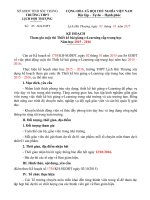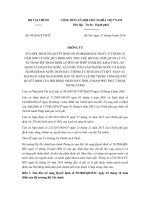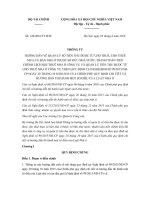E 124 94 (2016)
Bạn đang xem bản rút gọn của tài liệu. Xem và tải ngay bản đầy đủ của tài liệu tại đây (801.3 KB, 13 trang )
Designation: E124 − 94 (Reapproved 2016)
Standard Specification for
Weighing and Drying Apparatus for Microchemical Analysis1
This standard is issued under the fixed designation E124; the number immediately following the designation indicates the year of
original adoption or, in the case of revision, the year of last revision. A number in parentheses indicates the year of last reapproval. A
superscript epsilon (´) indicates an editorial change since the last revision or reapproval.
1. Scope
4. Weighing Bottles
1.1 This specification covers apparatus used for weighing
and drying operations in microchemical laboratory practice.
4.1 Weighing bottles of seven capacities shall conform to
the requirements in Table 2 and Figs. 4-9, inclusive.
1.2 The values stated in inch-pound units are to be regarded
as the standard. The metric equivalents may be approximate.
5. Weighing Cup
5.1 The weighing cup shall conform to the requirements
shown in Fig. 11, and shall be made of platinum-rhodium alloy
containing 3.5 % rhodium. The cup is designed to be used as a
sample container to fit into the weighing bottle shown in Fig.
5, and is useful for weighing hygroscopic materials.
NOTE 1—This specification was originally developed by the Committee
on Microchemical Apparatus, Division of Analytical Chemistry, American
Chemical Society.2
2. Referenced Documents
6. Weighing Tubes
2.1 ASTM Standards:3
E671 Specification for Maximum Permissible Thermal Residual Stress in Annealed Glass Laboratory Apparatus
E920 Specification for Commercially Packaged Laboratory
Apparatus
E921 Specification for Export Packaged Laboratory Apparatus
E1133 Practice for Performance Testing of Packaged Laboratory Apparatus for United States Government Procurements
E1157 Specification for Sampling and Testing of Reusable
Laboratory Glassware
6.1 Weighing tubes of three types shall conform to the
requirements shown in Fig. 12, Fig. 13, and Fig. 14. These
tubes should preferably be made of soda-lime glass.
7. Spatulas
7.1 Spatulas of four types, and preferably made of stainless
steel, shall conform to the following requirements:
7.1.1 Type A (Fig. 15)—This spatula is generally useful. The
top can be used for crushing crystals and the bent blade for
scraping containers.
7.1.2 Type B (Fig. 16)—This spatula has a flat bent portion
at one end and a V-shaped scoop at the other end. It is
particularly useful for weighing samples.
7.1.3 Type C (Fig. 17)—This spatula is suitable for the larger
samples commonly encountered in semimicro and preparative
work. It has a U-shaped scoop at one end and a V-shaped scoop
at the other end. The spatula can be used to add shot or beads
to tare flasks and for measuring and introducing solid reagent
into combustion tubes.
7.1.4 Type D (Fig. 18)—This spatula is useful in many
microchemical applications.
3. Combustion Boats
3.1 Combustion boats of three sizes shall conform to the
requirements in Table 1 and Fig. 1, Fig. 2, and Fig. 3. These
boats shall be made of platinum-rhodium alloy containing
3.5 % rhodium.
1
This specification is under the jurisdiction of ASTM Committee E41 on
Laboratory Apparatus and is the direct responsibility of Subcommittee E41.01 on
Laboratory Ware and Supplies.
Current edition approved Sept. 1, 2016. Published September 2016. Originally
approved in 1956. Last previous edition approved in 2010 as E124 – 94 (2010).
DOI: 10.1520/E0124-94R16.
2
See the “1949 Report on Recommended Specifications for Microchemical
Apparatus, Carbon-Hydrogen, Dumas Nitrogen, Sulfur and Halogen,” Analytical
Chemistry, Vol 21, December 1949, p. 1555; and the “1953 Report on Recommended Specifications for Microchemical Apparatus, Weighing and Drying,”
Analytical Chemistry, Vol 26, July 1954, p. 1186.
3
For referenced ASTM standards, visit the ASTM website, www.astm.org, or
contact ASTM Customer Service at For Annual Book of ASTM
Standards volume information, refer to the standard’s Document Summary page on
the ASTM website.
8. Forceps
8.1 Forceps of two types, made of nickel-plated steel, shall
conform to the following requirements:
8.1.1 Forceps with Platinum—5 % Ruthenium Tips (Fig. 19)
The pin serves as a stop to prevent the forceps from being
depressed to such an extent that the tips can open, allowing the
held object to drop. When pressed together, the tips make
contact for a distance of 1⁄4 to 1⁄2 in. (6.4 to 12.7 mm).
NOTE 2—Depending upon the intended use, other materials may be
Copyright © ASTM International, 100 Barr Harbor Drive, PO Box C700, West Conshohocken, PA 19428-2959. United States
1
E124 − 94 (2016)
8.1.2 Forceps with Conical Tapered Holders (Fig. 20)—
These forceps shall be made of spring steel. They are useful for
handling weighing tubes, absorption tubes, filter tubes, etc.
desiccator with cover and an aluminum insert which shall hold
securely the metal cooling block, Fig. 24. This combination
serves the same purpose as that described in Section 11, but
permits the additional use of drying agents of other chemicals
in the bottom container.
9. Tare Flasks
13. Drying Apparatus
9.1 Tare flasks of three types, made of soda-lime glass, shall
conform to the requirements shown in Fig. 21, Fig. 22, and Fig.
23. The serial numbers shall be etched on the flasks.
13.1 The drying apparatus shall be of the Abderhalden type
and shall conform to the requirements shown in Fig. 27.
substituted for the platinum alloy. Thec construction and over-all dimensions should be identical with those shown in Fig. 19.
NOTE 3—The shape of the tube attached to the ball joint, in the
desiccator bulb, is intended to prevent desiccant from being carried over
into the sample when the vacuum is broken. A cap for the ball joint and
stopper for the standard taper 40/50 joint may be used to protect the
desiccant when the bulb is disconnected and stands alone. The upward
indentation in the vapor tube prevents cooling of the drying chamber by
cold condensate.
10. Metal Cooling Block
10.1 The metal cooling block shall conform to the requirements shown in Fig. 24, and shall be made of a metal or alloy
with a high heat conductivity. The surface should be highly
resistant to abrasion and corrosion.
14. Maximum Permissible Thermal Residual Stress
11. Metal Crucible Container with Glass Cover
14.1 The stress in all glass items described herein shall
conform to Specification E671.
11.1 This assembly shall conform to the requirements
shown in Fig. 25, and shall consist of an aluminum body and
a borosilicate-glass cover. It may be used in combination with
the metal cooling block, Fig. 24. The combination, commonly
termed a “microdesiccator,” serves primarily as a container for
cooling, storage, and safe transportation of microweighing
equipment.
15. Sampling and Testing
15.1 For glass items, refer to Specification E1157.
16. Packaging
16.1 For packaging, select from Specification E920 or
E921, or Practice E1133.
12. Micro Glass Desiccator with Metal Insert
17. Keywords
12.1 The micro glass desiccator shall conform to the requirements shown in Fig. 26. It shall consist of a glass
17.1 apparatus; microchemical; weighing and drying
2
E124 − 94 (2016)
TABLE 1 Combustion Boats
Size
Figure
A
B
C
1
2
3
Use
for samples of 1 to 5 mgA
for samples of 5 to 25 mgA
for samples over 25 mgA,B
Approximate
Weight, g
0.45
0.7
1.5
A
For drying procedures, the Size A boat is used with the weighing bottle, Fig. 8.
Sizes B and C can be used either with the metal weighing bottles, Figs. 9 and 10,
respectively, or with the glass weighing bottles, pig-type, Figs. 6 and 7.
B
The Size C boat is especially suitable for bulky materials and explosive
substances, and for holding glass capillaries containing liquid samples.
FIG. 2 Combustion Boat, Size B
FIG. 1 Combustion Boat, Size A
FIG. 3 Combustion Boat, Size C
3
E124 − 94 (2016)
TABLE 2 Weighing Bottles
Figure
A
4
5
6B
7B,C
8D
9D
0D
Approximate
Capacity, mL
Approximate
Weight, g
0.05
0.75
3
3
0.5
1
2
0.6
2.5
5.0
5.7
1.5
4.5
6
Material
borosilicate glass
soda-lime glass
soda-lime glass
soda-lime glass
aluminum alloy
aluminum alloy
aluminum alloy
A
This bottle is intended for introducing samples into containers of small diameters.
The cap of the bottle shown in Fig. 5 may be used instead of the caps with rod
handle shown in Figs. 6 and 7.
C
This bottle, Fig. 7, is used for extremely hygroscopic materials; only the small
cap is removed for vacuum drying, and it is replaced as soon as the vacuum is
released. The bottle containing the combustion boat with sample may be attached
to a combustion tube by means of a rubber adapter, and the boat pushed into
position in the tube by passing a wire through the small joint.
D
These bottles are designed for use in conjunction with the combustion boats,
Figs. 1-3, as follows:
Bottle
Use with Boat
Fig. 8
Fig. 1
Fig. 9
Fig. 2
Fig. 10
Fig. 3
B
The combination is useful for weighing and drying extremely hygroscopic
material. Sample, boat, and bottle are weighed, and the combination, without
removing the cap, is placed in the drying apparatus (Fig. 27). During drying, vapors
escape through the capillary. After drying, the combination is reweighed.
FIG. 4 Weighing Bottle
FIG. 5 Weighing Bottle, Outside Cap
4
E124 − 94 (2016)
FIG. 6 Weighing Bottle, Pig-Type, with Outside Caps
FIG. 7 Weighing Bottle, Pig-Type, with Two Caps
FIG. 8 Weighing Bottle, Pig-Type, Metal, Size A
FIG. 9 Weighing Bottle, Pig-Type, Metal, Size B
5
E124 − 94 (2016)
FIG. 10 Weighing Bottle, Pig-Type, Metal, Size C
FIG. 11 Weighing Cup
FIG. 12 Weighing Tube
FIG. 13 Weighing Tube with Cap
6
E124 − 94 (2016)
FIG. 14 Weighing Tube with Vented Cap
FIG. 15 Spatula, Metal, Type A
7
E124 − 94 (2016)
FIG. 16 Spatula, Metal, Type B
FIG. 17 Spatula, Metal, Type C
8
E124 − 94 (2016)
FIG. 18 Spatula, Metal, Type D
FIG. 19 Steel Forceps (Nickel Plated) with Platinum - 5 % Ruthenium Tips
9
E124 − 94 (2016)
FIG. 20 Steel Forceps (Nickel Plated) with Conical Tapered Holders
FIG. 21 Tar Flask, Without Stopper, Small
FIG. 22 Tare Flask, Without Stopper, Large
10
E124 − 94 (2016)
FIG. 23 Tare Flask with Stopper
FIG. 24 Metal Cooling Block
FIG. 25 Metal Crucible Container with Glass Cover
11
E124 − 94 (2016)
Metric Equivalents
in.
mm.
0.040
11.0
⁄
3.2
18
⁄
4.8
3 16
⁄
6.4
14
⁄
11.1
7 16
FIG. 26 Glass Desiccator with Metal Insert
FIG. 27 Modified Abderhalden Drying Apparatus
12
⁄
14.3
9 16
⁄
19.1
34
27⁄16
61.9
E124 − 94 (2016)
ASTM International takes no position respecting the validity of any patent rights asserted in connection with any item mentioned
in this standard. Users of this standard are expressly advised that determination of the validity of any such patent rights, and the risk
of infringement of such rights, are entirely their own responsibility.
This standard is subject to revision at any time by the responsible technical committee and must be reviewed every five years and
if not revised, either reapproved or withdrawn. Your comments are invited either for revision of this standard or for additional standards
and should be addressed to ASTM International Headquarters. Your comments will receive careful consideration at a meeting of the
responsible technical committee, which you may attend. If you feel that your comments have not received a fair hearing you should
make your views known to the ASTM Committee on Standards, at the address shown below.
This standard is copyrighted by ASTM International, 100 Barr Harbor Drive, PO Box C700, West Conshohocken, PA 19428-2959,
United States. Individual reprints (single or multiple copies) of this standard may be obtained by contacting ASTM at the above
address or at 610-832-9585 (phone), 610-832-9555 (fax), or (e-mail); or through the ASTM website
(www.astm.org). Permission rights to photocopy the standard may also be secured from the Copyright Clearance Center, 222
Rosewood Drive, Danvers, MA 01923, Tel: (978) 646-2600; />
13









